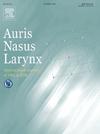CRSwNP患者FESS后主观和客观嗅觉结果的差异:预测因素和临床意义
IF 1.5
4区 医学
Q2 OTORHINOLARYNGOLOGY
引用次数: 0
摘要
目的慢性鼻窦炎合并鼻息肉(CRSwNP)常导致嗅觉功能障碍,促使患者寻求功能性内窥镜鼻窦手术(FESS)改善。然而,由于改善率的可变性以及主观自我评估和客观嗅觉测试之间的差异,预测术后结果是具有挑战性的。本研究旨在确定术前与术后主观和客观嗅觉结果差异相关的临床因素,以便更好地进行患者咨询和结果预测。方法回顾性研究100例无covid -19相关嗅觉功能障碍病史的CRSwNP患者,接受双侧全屋FESS治疗。分析的数据包括人口统计学特征、术前隆德-麦凯和嗅觉裂评分、血嗜酸性粒细胞、免疫球蛋白E水平、术前丁醇阈值测试(BTT)评分、主观嗅觉评分、嗅觉缺失状态和对宜人气味的反应。术后嗅觉结果采用BTT和5级主观嗅觉功能量表进行评估。逻辑回归确定了主观和客观结果之间差异的预测因素。结果术前BTT评分(β=-0.682, p <;0.001)和嗅觉缺失状态(β=-0.214, p = 0.01)独立影响客观嗅觉结果,而术前5级嗅觉功能量表影响主观嗅觉结果(β=-0.506, p <;0.001),嗜酸性粒细胞百分比(β=-0.218, p = 0.016)和腮腺(β=-0.182, p = 0.038)。术前5级评分较低显著预测差异(p = 0.001;优势比= 0.335)。结论FESS术后主观嗅觉结果与客观嗅觉结果存在差异,尤其是术前主观嗅觉功能障碍严重的患者。排除与covid -19相关的病例,术前和术后结合心理生理和主观评估对于全面评估和有效的患者咨询至关重要。本文章由计算机程序翻译,如有差异,请以英文原文为准。
Discrepancies between subjective and objective olfactory outcomes after FESS in CRSwNP: predictive factors and clinical implications
Objective
Chronic rhinosinusitis with nasal polyps (CRSwNP) frequently leads to olfactory dysfunction, prompting patients to seek functional endoscopic sinus surgery (FESS) for improvement. However, predicting postoperative outcomes is challenging due to variability in improvement rates and discrepancies between subjective self-assessments and objective olfactory tests. This study aimed to identify preoperative clinical factors associated with discrepancies between subjective and objective postoperative olfactory outcomes, enabling better patient counseling and result prediction.
Methods
This retrospective study included 100 CRSwNP patients without a history of COVID-19-related olfactory dysfunction who underwent bilateral full-house FESS. Data analyzed included demographic characteristics, preoperative Lund-Mackay and olfactory cleft scores, blood eosinophils, immunoglobulin E levels, preoperative butanol threshold test (BTT) scores, subjective olfactory scores, parosmia status, and responses to pleasant odors. Postoperative olfactory outcomes were evaluated using the BTT and a 5-grade subjective olfactory function scale. Logistic regression identified predictive factors for discrepancies between subjective and objective outcomes.
Results
Preoperative BTT score (β=-0.682, p < 0.001) and parosmia status (β=-0.214, p = 0.01) independently influenced objective olfactory outcomes, while subjective outcomes were affected by preoperative 5-grade olfactory function scale (β=-0.506, p < 0.001), eosinophil percentage (β=-0.218, p = 0.016), and parosmia (β=-0.182, p = 0.038). Lower preoperative 5-grade scores significantly predicted discrepancies (p = 0.001; odds ratio=0.335).
Conclusion
Discrepancies between subjective and objective olfactory outcomes after FESS are common, particularly in patients with severe preoperative subjective olfactory dysfunction. Excluding COVID-19-related cases, incorporating both psychophysical and subjective assessments pre- and postoperatively is critical for comprehensive evaluation and effective patient counselling.
求助全文
通过发布文献求助,成功后即可免费获取论文全文。
去求助
来源期刊

Auris Nasus Larynx
医学-耳鼻喉科学
CiteScore
3.40
自引率
5.90%
发文量
169
审稿时长
30 days
期刊介绍:
The international journal Auris Nasus Larynx provides the opportunity for rapid, carefully reviewed publications concerning the fundamental and clinical aspects of otorhinolaryngology and related fields. This includes otology, neurotology, bronchoesophagology, laryngology, rhinology, allergology, head and neck medicine and oncologic surgery, maxillofacial and plastic surgery, audiology, speech science.
Original papers, short communications and original case reports can be submitted. Reviews on recent developments are invited regularly and Letters to the Editor commenting on papers or any aspect of Auris Nasus Larynx are welcomed.
Founded in 1973 and previously published by the Society for Promotion of International Otorhinolaryngology, the journal is now the official English-language journal of the Oto-Rhino-Laryngological Society of Japan, Inc. The aim of its new international Editorial Board is to make Auris Nasus Larynx an international forum for high quality research and clinical sciences.
 求助内容:
求助内容: 应助结果提醒方式:
应助结果提醒方式:


